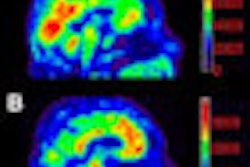CHICAGO - FDG-PET is more cost-effective in an initial workup of dementia patients, while amyloid PET imaging is more cost-effective as the secondary imaging option in a tertiary care setting, according to a study presented on Monday at the RSNA 2011 conference.
In a comparison of cost per patient for both imaging techniques, as well as their diagnostic accuracy, researchers from the University of Washington in Seattle also found that the average cost per patient increases significantly if either FDG-PET or amyloid PET is used outside of a dementia center with lower pretest probability.
The worldwide cost for dementia in 2010 was estimated at $604 billion, noted lead study author Dr. Christopher Potter, who presented the results. "With the promise for treatment, there is more need for accurate diagnosis. We have FDG-PET for limited indications and amyloid PET may also be available clinically soon," he said. "The question is: How do we use these diagnostic tools most effectively?"
Potter and colleagues developed a cost-effectiveness model for selecting the diagnostic workup order of FDG-PET and amyloid PET when differentiating three common neurodegenerative disorders: Alzheimer's disease, frontotemporal dementia, and dementia with Lewy body disease. A fourth category titled "other" included healthy individuals.
They also developed two diagnostic workup approaches:
- FDG-PET imaging first, followed by amyloid PET if FDG-PET results were inconclusive or indeterminate
- Amyloid PET imaging first, followed by FDG-PET if amyloid PET results were inconclusive or indeterminate
If the first scan showed true or false positive findings, no additional imaging was performed.
Using previous research, Potter and colleagues fixed sensitivity and specificity for FDG-PET at the lowest possible and highest possible values. "Because we don't have good characterization of sensitivity and specificity for all disorders, we varied amyloid PET through reasonable ranges of sensitivity and specificity," Potter added.
The group also fixed the cost for FDG-PET at $1,121 per scan based on an estimated Medicare reimbursement rate. For amyloid PET, Potter and colleagues valued cost at three different tiers -- $1,000, $2,000, and $3,000 -- for the comparison.
They then tested the comparisons in three different scenarios, whereby the most accurate diagnosis would be achieved for each dementia category, looking at Alzheimer's and dementia with Lewy body disease together and comparing them to other dementias in the case of cholinesterase inhibitor use, and Alzheimer's compared to dementia with Lewy body disease in cases of neuroleptic treatment.
When sensitivity was 95% for amyloid PET to detect Alzheimer's or dementia with Lewy body disease, initial FDG-PET imaging was more cost-effective when amyloid PET imaging cost was 4% greater than the cost of FDG-PET imaging. There was also a lower misdiagnosis rate of 18% for FDG-PET, compared with 21% for amyloid PET imaging as the first option.
When amyloid PET sensitivity was in the range of 60% to 100%, the average cost per patient with amyloid-first imaging decreased. Amyloid PET imaging approached FDG-PET as a first option for average cost per patient only when amyloid PET imaging's sensitivity was close to 100%, and the misdiagnosis rate surpassed FDG-PET-first imaging only when sensitivity was greater than 90%.
"These results indicate that it is more cost-effective to use FDG-PET in initial dementia workup and amyloid imaging as the secondary imaging tool in a tertiary care setting," Potter and colleagues wrote. "Over a wide range of diagnostic accuracy of amyloid PET, FDG first is cost-effective, and the [misdiagnosis or inconclusive] rate is comparable until amyloid PET sensitivity is over 90%. If either PET study is used outside of a dementia center with lower pretest probability, the average cost per patient increases significantly."




















